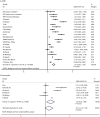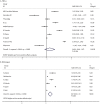Inflammatory Markers and the Risk of Chronic Obstructive Pulmonary Disease: A Systematic Review and Meta-Analysis
- PMID: 27104349
- PMCID: PMC4841528
- DOI: 10.1371/journal.pone.0150586
Inflammatory Markers and the Risk of Chronic Obstructive Pulmonary Disease: A Systematic Review and Meta-Analysis
Abstract
Systemic inflammatory factors are inconsistently associated with the pathogenesis of chronic obstructive pulmonary disease (COPD). We conducted a systematic review and meta-analysis to summarize the evidence supporting the association between systemic inflammation and the risk of COPD. Pertinent studies were retrieved from PubMed, EmBase, and the Cochrane Library until April 2015. A random-effects model was used to process the data, and the analysis was further stratified by factors affecting these associations. Sensitivity analyses for publication bias were performed. We included 24 observational studies reporting data on 10,677 COPD patients and 28,660 controls. Overall, we noted that COPD was associated with elevated serum CRP (SMD: 1.21; 95%CI: 0.92-1.50; P < 0.001), leukocytes (SMD: 1.07; 95%: 0.25-1.88; P = 0.010), IL-6 (SMD: 0.90; 95%CI: 0.48-1.31; P < 0.001), IL-8 (SMD: 2.34; 95%CI: 0.69-4.00; P = 0.006), and fibrinogen levels (SMD: 0.87; 95%CI: 0.44-1.31; P < 0.001) when compared with control. However, COPD was not significantly associated with TNF-α levels when compared with control (SMD: 0.60; 95%CI: -0.46 to 1.67; P = 0.266). Our findings suggested that COPD was associated with elevated serum CRP, leukocytes, IL-6, IL-8, and fibrinogen, without any significant relationship with TNF-α.
Conflict of interest statement
Figures
References
-
- Mannino DM, Buist AS. Global burden of COPD: risk factors, prevalence, and future trends. Lancet. 2007; 370: 765–773. - PubMed
-
- Vernooy JH, Kucukaycan M, Jacobs JA, Chavannes NH, Buurman WA, Dentener MA, et al. Local and systemic inflammation in patients with chronic obstructive pulmonary disease: soluble tumor necrosis factor receptors are increased in sputum. Am J Respir Crit Care Med. 2002; 166: 1218–1224. - PubMed
-
- Connors AF Jr., Dawson NV, Thomas C, Harrell FE Jr., Desbiens N, Fulkerson WJ, et al. Outcomes following acute exacerbation of severe chronic obstructive lung disease. The SUPPORT investigators (Study to Understand Prognoses and Preferences for Outcomes and Risks of Treatments). Am J Respir Crit Care Med. 1996; 154: 959–967. - PubMed
-
- Agusti AG, Noguera A, Sauleda J, Sala E, Pons J, Busquets X. Systemic effects of chronic obstructive pulmonary disease. Eur Respir J. 2003; 21: 347–360. - PubMed
-
- Agusti AG. Systemic effects of chronic obstructive pulmonary disease. Proc Am Thorac Soc. 2005; 2: 367–370; discussion 371–362. - PubMed
Publication types
MeSH terms
Substances
LinkOut - more resources
Full Text Sources
Other Literature Sources
Medical
Research Materials
Miscellaneous





